This blog has involved many hours researching historical deeds and has taken a long time to put together. It has been challenging to access information while travelling full-time, well away from Tasmania.
I have called upon others to assist me in completing this story. Thank you to Brian Rollins for his patience and kindly sharing information on how to work through the historical Tasmanian title index cards and historical deeds, all found online. Brian also carried out some last minute searches on some hard-to-find dealings and provided useful background material on why missing land dealings are as they are. My former colleague at Gunns, Tony Clifford, rekindled his experience in conveyancing and carried out additional research. He helped enormously by filling in the gaps on title dealings that I could not find. He also supplied newspaper clippings on some of those involved in the conveyances. Nic Haygarth provided some useful background material on the Fields and contact details of Joe Fagan junior. Thanks also to James Dick for supplying the information I requested via email. Lloyd Wilson, as usual, was happy to answer my queries about the Guildford blocks. John Dart gave me some valuable information about the ‘school block’ at Guildford (and other material worthy of a future blog or two) and his dealings with the property.
In Chapter 2 of my book “Fires, Farms and Forests”, I went into detail about the decision to survey Surrey Hills into smaller blocks in preparation for sales. The Van Diemen’s Land Company (VDL Co.) were desperate to earn meaningful revenue from this large and isolated property. From 1848 to 1903, the whole of Surrey Hills was leased by the Field brothers. Based near Deloraine, they ran wild mobs of cattle across the unfenced Surrey and Hampshire Hills, Middlesex Plains, and the Crown lands in between, without carrying out any improvements. In return, the VDL Co. received little income.
The VDL Co. wanted to explore ways to attract bonafide settlers prepared to carry out improvements on Surrey Hills and make the area more attractive to subsequent settlers. So, in November 1901, they engaged Percy Sams to survey Surrey Hills to sell off blocks of land. Sams’ created 11 blocks varying in size from 2,000 acres to 24,000 acres in a grid pattern, each block known by a unique letter of the alphabet.[1]
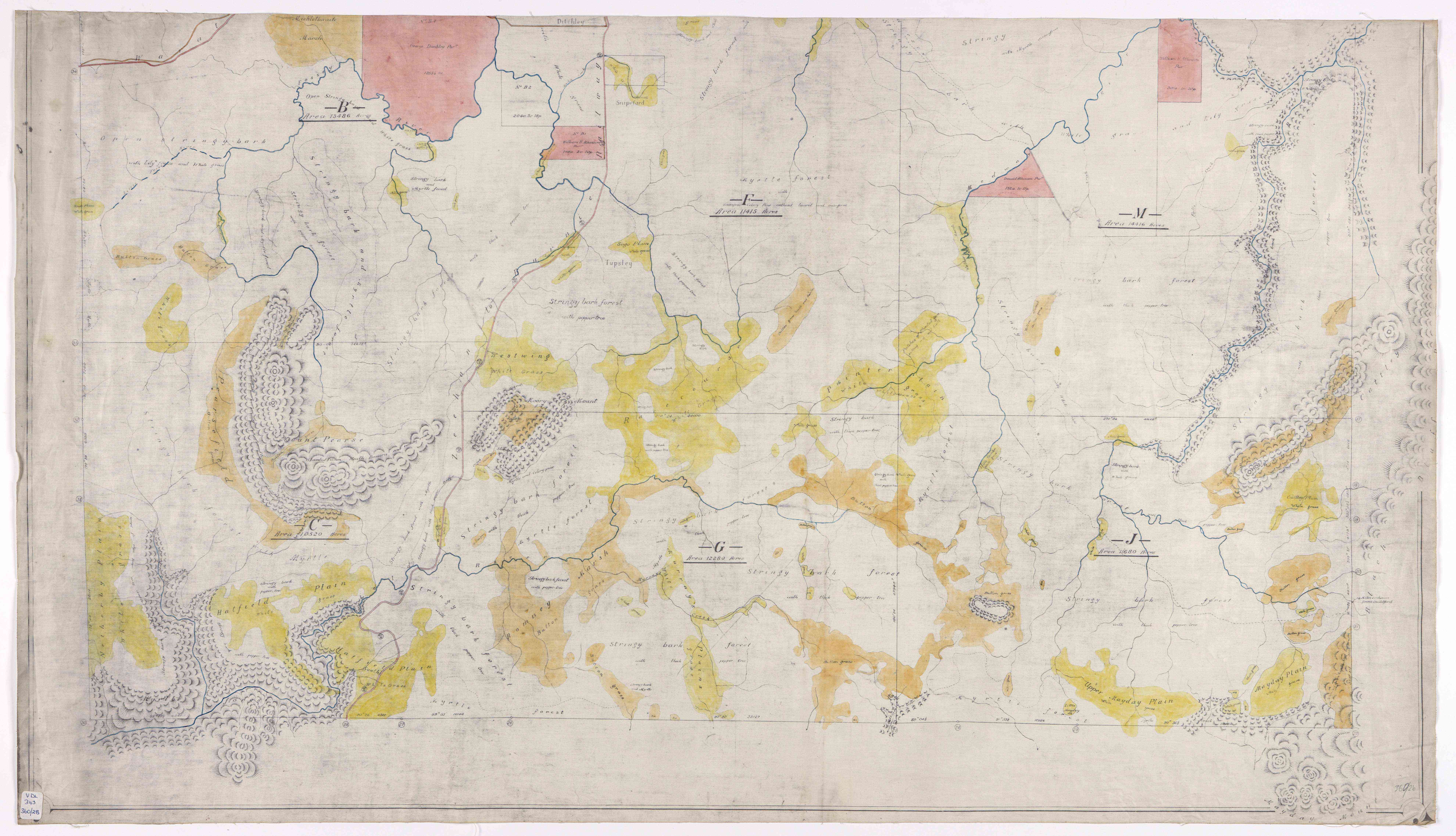
After Sams’ survey, there was a change in VDL Co. Chief Agents in Tasmania. Andrew Kidd McGaw replaced James Norton Smith in February 1903. McGaw was keen to attract tenants to a “naturally fertile area of virgin country” that had remained undeveloped for so long. Initially, McGaw allowed prospective tenants to lease ground on Surrey Hills. The problem, however, was that most of Surrey Hills remained relatively inaccessible and suffered severe weather conditions most of the year. Thus, despite plenty of water, Surrey Hills was only ever suitable for rough grazing.
The lease and sale of portions
William Henry Atkinson, was the pioneer selector on Surrey Hills, along with his three sons, most notably Donald Campbell Atkinson. They were the first to lease land on Surrey Hills after McGaw became the Chief Agent. Atkinson leased 4,000 acres between Burghley and Thompsons Park. Both Burghley and Thompsons Park themselves were considered the better grazing areas on Surrey Hills. He also leased 150 acres at Guildford for experimental cropping. However, he mainly used the area to herd cattle from his other larger blocks on Surrey Hills. In 1904, Atkinson built the hut that is currently standing at Thompsons Park to house his stockmen. After 12 months, even though Atkinson had ringbarked 300 acres at Burghley and fenced and scrubbed the Guildford lease, he had trouble making any money from his large lease and negotiated a smaller area down to 2,110 acres.
Other areas were leased, all on seven-year terms. They included 90 acres at Guildford by Thomas Allen and 96½ acres by Edward Brown (E6). Brown also leased half an acre adjoining the railway platform on a 40-year Building Agreement to build a boarding house. Clearing of these leases occurred during the latter half of 1903. The VDL Co. cleared Section E3. Atkinson repaired fences at Chilton (A1) to aid in his cattle mustering and formally organised to use the land under a lease.
The original school building at Guildford burnt down in December 1902. In late 1903 the VDL Co. agreed to donate a free grant of one acre to the Department of Education to build a new school and schoolhouse at Guildford. The buildings were completed in January 1904.
In early 1904, Guildford school teacher Hannah May Wells and her miner husband, William, leased 19 acres, and Station Master Thomas Dawson four acres, both at Guildford.
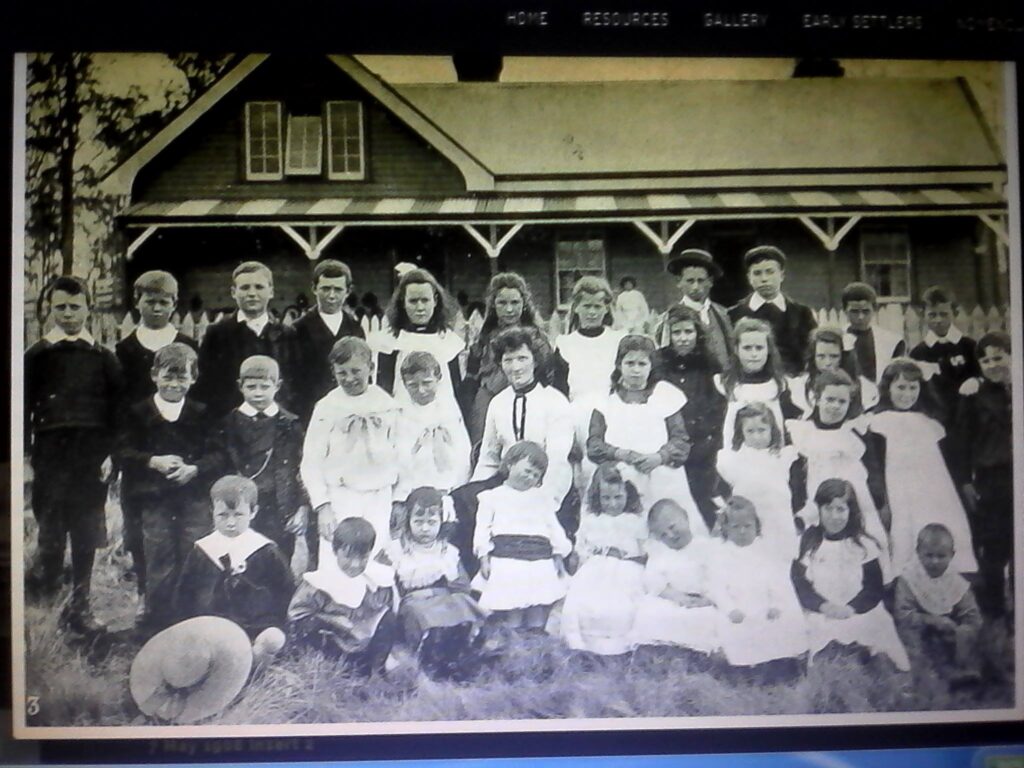
In November 1905, McGaw wrote to the directors conceding that many parts of Surrey Hills would not attract reasonable lease rates. He believed that most of the property was unlikely to attract any interest from graziers. He suggested that the better land, along the railway and the Burnie to Waratah road, should be sold in alternate blocks and ¼ acre allotments offered at Guildford township for housing. The directors agreed to sell lots not exceeding 10,000 acres. They placed advertisements in the Tasmanian newspapers. The most interest came from the west coast residents, who were used to heavy rainfall.
It was no surprise that Atkinson, already grazing cattle on leased runs, was first to act. He offered to buy 150 acres at Muddy Creek (B1)[2] and 150 acres at Chilton (A1). They were surveyed in December 1905.[3] The VDL Co. advertised on the mainland their willingness to sell land at Surrey and Hampshire Hills. Mainlanders who inspected these areas and made an offer, refused to wait for any sale acceptance months later from the directors in London. McGaw sought pre-approval to deal directly with prospective mainland purchasers without reverting to the directors, without success.
More purchasers followed in 1906. Gippsland farmer, Henry Price, inspected Surrey Hills a couple of times to purchase 400-500 acres. Instead, he opted to lease 950 acres at Racecourse Plain (F2G1) over seven years and planned to build a cottage and fence the land. McGaw sold 200 acres near Muddy Creek (B2) to Frederick Peters. However, the sale was cancelled a few years later after Peters only paid the interest on his overdue instalments and the VDL Co. did not want that arrangement to continue. John Twinning agreed to purchase 200 acres near Micklethwaite (B3), Charles Every 150 acres on the Hellyer River (A2) and Hannah Wells and her husband 147 acres at Guildford (F2), adjoining the railway line about 1½ miles south of Guildford. Wells’ fenced and improved the property, but they left Guildford in 1909 and were in arrears with their instalments. In 1915 the VDL Co. cancelled the contract. The contracts for Price, Twinning and Every also lapsed without a sale.
The VDL Co. entered into many grazing leases. John Twinning leased 294 acres (B4) adjoining his purchase block and Edward Brown 1,115 acres at Romney Marsh (G3), and 997 acres at Hatfield (G2). Hugh Dallas, the son-in-law of W. H. Atkinson, leased 388 acres south of Guildford along the railway line (F3). George Hanson leased 97 acres near Rouses’ Camp (A6) and 396 acres nearby (B8), while John Hays leased 764 acres fronting the railway (B9). Hays sub-leased his block to Atkinson for £15 per annum to alleviate his £38 per year lease rate. Joseph North leased Micklethwaite Marsh (B6) at 367 acres. He also leased a smaller 15-acre section (B6a).
In the winter of 1906, McGaw optimistically reported on successful negotiations for more purchases and leases. He attributed the success to Donald Atkinson, an expert horseman who knew Surrey Hills very well. Frank Morris, from Stowport, agreed to lease 1,279 acres on Surrey Hills (A3) along the railway and, after failing to make a go of it, sub-leased his block to George Dunkley, the Managing Director of Dunkley Bros Ltd.[4] Herbert Cronks had agreed to lease two blocks, one at 1,000 acres and another at 800 acres. Another 1,200 acres at Goderich Plain was sold to George Turnbull from Gippsland. However, McGaw’s optimism was short-lived as he heard nothing further from Cronks or Turnbull. They were acquaintances of Price, and McGaw believed they were put off returning to Surrey Hills because of the disappointment expressed by Price after his first winter on Surrey Hills. During 1908 the demand for land ceased on Surrey Hills. Morris, Hays and Dallas repeatedly asked to be relieved of their leases. Only Dallas had stocked his land during winter while the other two left their runs empty.
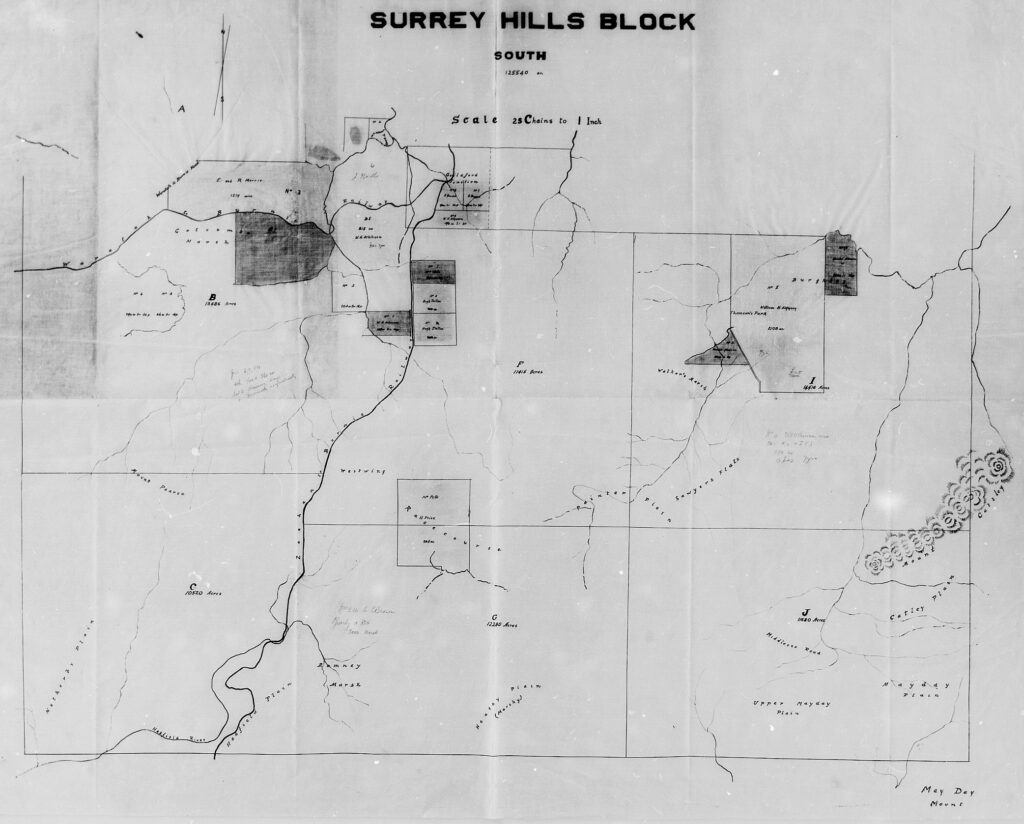
George Dunkley enquired about buying 600-800 acres at 30 shillings an acre, which the VDL Co. directors baulked at, mainly since the land he was interested in fronted the railway and covered good land between the Hellyer River and Micklethwaite Marsh. He did buy 1,255 acres in December 1906 (B7) at that rate but immediately sought to have the purchase price reduced to 20 shillings per acre. Subsequently, Dunkley accused McGaw of over persuasion on the sale. Meanwhile, Price, who had paid £15 on taking possession of his land at Racecourse Plain, advised McGaw that he was abandoning the lease when his first rental payment was due as the winter in the area was too severe. As a result, cattle and horses died, and he lost all of the swede crops he planted.
The suitability of Surrey Hills as a cattle run in small areas was questioned by all tenants after the 1907 winter. They suffered heavy losses, and cattle brought to the coast were in such a poor condition they did not fetch the prices initially paid for them.[5]
By the end of 1908, the VDL Co. sold 2,121 acres on Surrey Hills at an average of 32 shillings an acre. A further 11,141 acres were leased, providing an annual income of £475. Atkinson was keen to purchase more land, including the pick of the estate at Burghley. The VDL Co., however, did not want to sell land already under lease. Atkinson offered to buy around 100 acres at Chilton (A1) and use the remains of a cottage built by the Fields, and in ruins, to house a worker to run a dairy to supply milk to Waratah.
The terms applying to the land sales were that the purchase price could be paid in cash, or the purchaser may elect to accept credit terms paying instalments over 14 years. Ten per cent of the purchase price was payable as a deposit on completion of a survey and the balance in fourteen equal payments, each yearly payment bearing interest from the date of purchase at 8 per cent. The survey fees become payable when the land was selected. Leases were offered over a 7-year term.
The directors were concerned that purchasers were picking the eyes out of Surrey Hills. McGaw defended the sales by pointing out that even though cleared land was targeted, it was not necessarily the best land but rather land that could immediately be fenced and stocked. He believed the best land was a mixture of native grassland and part bush which could be scrubbed and sown with introduced grasses. The former was winter feed and the latter for fattening during summer. McGaw used the example of Wells’ block at Guildford (F2), which had helped attract purchasers and lessees. Wells had sub-divided her land into small paddocks and had one in English grasses, and the others in ‘almost every kind of vegetable which grows luxuriantly’.
During 1909, the focus of dealing with Surrey Hills shifted to Baillieu, Patterson and Company and Gerald Mussen’s interest in purchasing the balance of Surrey Hills not already sold.[6] When those initial negotiations failed, McGaw turned his attention to the leases that were due to expire at the end of March 1910 – Atkinson’s Burghley and Guildford leases. Atkinson had an option to renew at double the lease rate, which he was not keen to exercise and instead sought compensation for the improvements he made. McGaw convinced him to continue his Burghley lease at the current lease rate. However, he refused a full term of seven years and wanted a yearly lease. He was worried the new Federal Land Tax legislation would affect him. He declined to renew the Guildford lease saying, ‘even if he is given it for nothing’. Instead, he offered to lease 200 acres at Tommy Walker Marsh as well as Blackmarsh. Brown’s 96½ acre lease at Guildford (E6) was also up for renewal, and he was aggrieved that the VDL Co. did not remind him to give notice on time to claim compensation for improvements as he was not willing to continue. Despite spending a good deal of money improving the land, he received little return.
Atkinson ringbarked the timbered country adjoining the Medway River at Thompsons Park (M2) before finalising to purchase the block in December 1916. The purchase of Burghley (M3) was finalised three months later and Chiltern (A1) the following July.
Dunkley Bros Ltd paid their first instalments and had spent £700 on their land (B7) but claimed they had no return. George Dunkley refused to pay the interest due for late payment because he still believed the purchase price was too high. The directors, wary of setting any precedent of relaxing contract terms, agreed to charge five per cent interest rather than the eight per cent on the contract. He had paid up to December 1910 but since then had paid no further instalments. McGaw convinced Dunkley to pay his outstanding instalments and interest at the reduced rate of five per cent. By 1922, Dunkley owed the last two instalments totalling £426. McGaw got him to finance the outstanding amount through his bank.
There was a lot of interest for land on the Ringwood Estate in 1912, mainly because of the proximity to the main road and railway and on ground that had been logged, scrubbed and sown with introduced pastures. I will only focus on the three parcels that were purchased back by AFH.
In November 1912, Christian Henry Stitz, a blacksmith in Queenstown, purchased 64 acres at Ringwood (K3a) for £144-13. Stitz, along with his brother and business partner, David, also had a contract of sale for the adjoining block (K3), 179 acres fronting the railway line at the 221/2 mile. They finalised the latter sale in 1920 after the instalments were paid. Christian Stitz relinquished his business interests in Queenstown and moved to Hampshire in 1925. He was considered a pioneer in the development of the Hampshire region. For example, he grew the first government-certified potatoes on his property. In 1914, Ernest Owen, a farmer from Warnambool, moved to Hampshire and bought a 204-acre block (K2) in the north-east corner of Ringwood.
McGaw reported in 1915 that the first parcel of land to be sold at Guildford was a quarter-acre block (Lot 16) to Thomas Allen for £20, where he built a cottage. However, there is no official record of any sale. Given Allen’s felony record, it is likely that he defaulted on payment and never got title to the land. Instead, official conveyance records show the sale of this block to W. H. Atkinson on 11 October 1916 for £35. In 1915, Edward Brown indicated he wanted to purchase his Guildford lease (Lot 21) as he had plans to improve the block significantly and sow it with improved pasture. In addition, he wanted to fence the block and build a cottage for one of his sons. He planned to live permanently at Guildford, so he offered £50 for his half-acre allotment and £2-10-0 per acre for Section E6.[7]
In 1916, Robert George Hales, the manager of the Magnet silver mine, wanted to buy land at the extreme north-west of Surrey Hills at £1 per acre cash.[8] Norton Smith had offered the land to him previously at £11/2 per acre without success. Eventually, block A7 (249 acres) was sold to Hales that year. He bought another 172 acres in 1921 (A8).
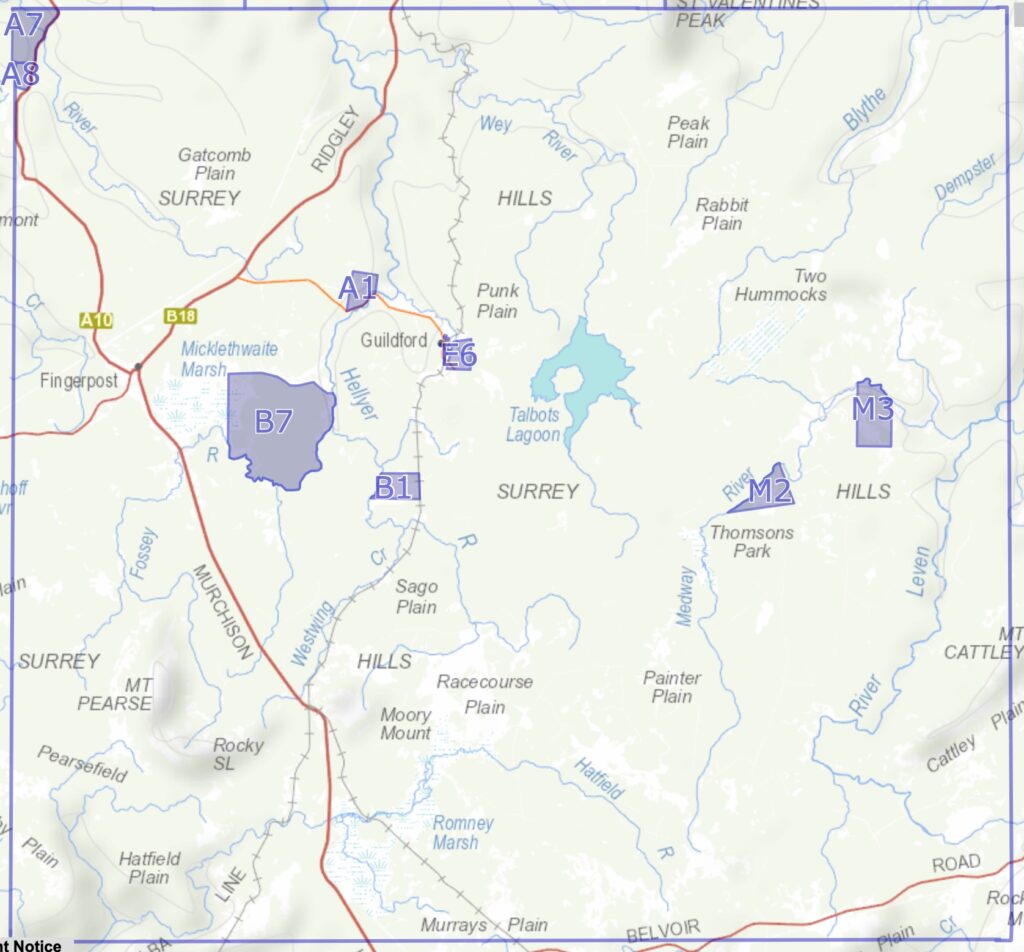
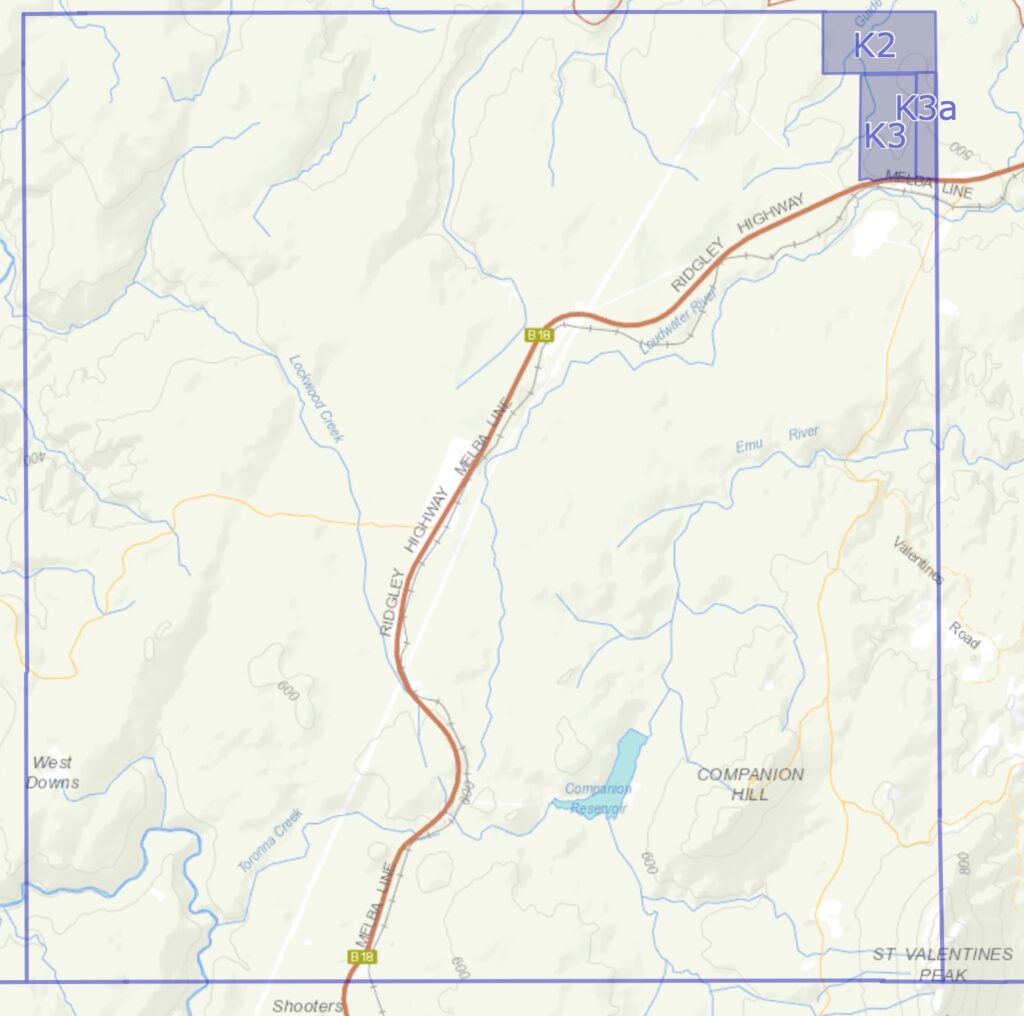
Further land dealings
When WH Atkinson died on 10 December 1918, McGaw, and his son Donald Atkinson, were nominated as executors and trustees of his will. McGaw, however, refused to have anything to do with the administration of the estate. So he was replaced by Donald’s half-brother William Henry Atkinson (junior), and solicitor Frank Bathurst Edwards.
The trustees sold the Chilton (A1) and Clipper East (B1) blocks in 1924 to Irishtown farmer William Dean Winspear. He later sold the blocks to his brother, Roger Wardle Winspear. Roger was born in Devonport in 1886. After working for auctioneers, WT Bell & Co in Launceston, he moved to Burnie, where he opened his own business. During this period, he took an interest in land at Surrey Hills and bought a few blocks. Atkinson sold the Thompson Park (M2), and Burghley (M3) blocks to Roger Winspear in 1926. Winspear also bought Lot 16 at Guildford in 1924.
Winspear then offloaded Thompsons Park (M2), Burghley (M3), Chilton (A1) and Clipper East (B1) to descendants of the Field family in 1928. Miss Ethelyn Field bought Chilton (A1) and Clipper East (B1). Richard Randle Field bought Burghley (M3), and Richard Charles Field bought Thompsons Park (M2). It was very ironic to learn that after such a long association with Surrey Hills in the nineteenth century, the Field family returned to Surrey Hills 25 years later. All three blocks were later transferred to the family company, Western Highlands Pty Ltd in 1931, the same year of Ethelyn’s death. [9]
In 1940, Donald Atkinson bought back Chilton (A1) and Clipper East (B1) blocks and in 1944, Thompsons Park (M2) and Burghley (M3) blocks.
Ernest Owen died in 1920, and K2 passed onto his wife. She sold the block to Hampshire farmer Albert Jago in 1941. Charles William Deacon then purchased it in 1944 who then sold it to Hobart factory worker, Walter Henry Crispin in 1955.
In 1927, Christian Stitz bought out his brothers share of K3 and K3a. Stitz died in 1946, and his will appointed his sons Claude Henry Stitz and Frank Thomas Stitz as Trustees. His real estate assets were held in trust for a future sale after his wife’s death. She died on 5 January 1955. However, it was subsequently found out that this land was not included in the requirements of his will. Claude, who lived in Melbourne, agreed to assign the land to his brother Frank. In July 1955, Frank Stitz sold to Walter Hugh Crispin.
Renowned bushman, fur trapper, long-time Guildford resident, and good friend of Donald Atkinson, Luke Etchell bought Thompsons Park (M2) and Burghley (M3) in 1944. In 1946, on his first visit to Surrey Hills accompanied by Etchell, Reg Needham recommended that Papermakers Pty Ltd[10] buy Etchell’s blocks for the same price he had paid for them and in return grant him a snaring lease free of charge for as long as he wanted (he was 78 years old!). According to Needham, Etchell was agreeable and was willing to assist in his knowledge of Surrey Hills. However, conveyancing records show that just before his death, he sold those blocks to Guildford Junction station master Frank Burridge in 1947.
Donald Atkinson sold Chilton (A1) and Clipper East (B1) blocks to his son Lindsay Byworth Atkinson in 1946.
Dunkley Bros Ltd amalgamated with Circular Head Timber and Kiln Seasoning Company and EH Fenton Pty Ltd to form Circular Head Amalgamated Timbers Pty Ltd in 1940. In 1949, Kauri Timber Company Ltd bought Circular Head Amalgamated Timbers Pty Ltd. After illegal grazers caused a large fire in this block in 1960, AFH decided to lease this block for five years at an annual rate of £50 to control the illegal grazing. The lease agreement did not give AFH any rights to commercially harvest timber on the property. However, it is believed that the lease continued for many years, which was allowed in the original agreement.
In 1941, Papermakers Pty Ltd gave Cumming Brothers a 10-year exclusive licence to cut and remove sawlogs from 6,500 acres around Guildford, and the myrtle rainforest area near Painter and Racecourse Plains. They were also permitted to set up a sawmill which was erected on Block E6 at Guildford. After Edward Brown died in 1932, his will passed on the land to his two sons. They sold the block to Cumming Bros in 1947 for £350. The Cumming Bros sawmill was an electric-powered mill with a circular saw breaking-down unit. Logs were pulled to the mill skids by horse teams.
The two blocks in the far north-west corner of Surrey Hills (A7 and A8) were still owned by Hales when he died in January 1936. His executor and trustee sold the land in 1950 to Trevor Thomas Berwick, a forest ranger from Guildford employed by Forest Supplies Pty Ltd.[11] Hale’s will was not registered in the Tasmanian Deeds Office until that year. Berwick then sold the two blocks to Burnie publican Wilfred (Wif) James Campbell in October 1953. Campbell built the Menai Hotel in the early 1950s on Captain William Jones’s homestead site Menai.[12] Campbell was also a sawmiller and ran a sawmill on those properties while harvesting the timber.
Edward Brown ran the Guildford railway station refreshment room until 1923. He and his wife left Guildford in 1927 and sold Lot 21 to the Emu Bay Railway Company in 1929 for £500.
Needham’s inspection and his concerns about grazing activities detrimental to forestry
As I mentioned in my book newly appointed forester Reg Needham first saw Surrey Hills in early January 1946. He travelled on horseback with Luke Etchell of Guildford as a guide. He inspected the eastern and southeastern portions along the watersheds of the Wey, Medway, Leven, Hatfield and Hellyer Rivers. Over three days, they travelled about 56 miles on horseback and 18 miles on foot through “different country practically all the time”. The first day they left Guildford and rode out over the Wey down over Blackmarsh, climbed up on the eastern end of the Hummocks, rode through the Medway Valley and camped at the Thompsons Park hut for the night. The next day, they rode out along the Leven-Medway divide through Sawyers and Leven Flats to Mayday Plain, inspected the block’s southern and eastern boundaries, and then climbed up on the Black Bluff Range to get a view over the area. They then returned to Thompsons Park and inspected the western portion of the Cummings Bros myrtle lease. They rode past Tommy Walker Marsh to Painter Plain on the third day, then down over Kildare and the African Marsh to Murray’s Plains. Then returned to Guildford via Romney Marsh and the Racecourse. On the way back, they inspected the southern portion of Cumming Brothers myrtle lease.
Needham saw many areas affected by cattle grazing and fire. He wanted to curtail grazing in the open forest country where “graziers had a free run…[and] regrowth was continually destroyed by burning and gazing of the tender shoots of the seedlings which cannot cease too soon”. There were reports of Field’s cattle still on Surrey Hills in the late 1920s at Burghley and Murrays Plains. The VDL Co. also had their own cattle on Pearsefield until the 1930s.
By the time Needham arrived at Surrey Hills in 1946, there were many active grazing leases on Surrey Hills. A block on the Hellyer River (A4) of 65 acres, first leased to W. H. Atkinson in 1906, was now run by his son Donald Atkinson. Walter Hills leased a number all of blocks, including B3, B4, B6, B8 and B9 and open feeding ground to the south. An area near the junction of the Hellyer and Wey Rivers on the Burnie to Waratah Road was leased by L. S. Cumming.
There were a few small, inconsequential leases around Guildford. Frank Burridge had a lease on two allotments, while Charlie Wilson, George Luke, Edgar Luke and Stan Pitham each leased one small allotment. Denny Murray fenced his small allotment to reduce his annual lease payment.
Bill North leased the open woodland country south of the Waratah-Guildford road, west of the Emu Bay Railway, where fires were deliberately lit in 1945-1946. Needham lamented that fires destroyed regrowth saplings and the cattle removed the tender shoots of the seedlings. He wrote, “grazing cannot be stopped too soon in this country”.
While Needham was happy to see grazing continue on the open plains, he believed the only way it could be carried out satisfactorily was by the company running cattle itself.[13] Until that could be put into place, Needham was very selective with who could continue grazing. By the end of 1947, all the above leases were terminated. However, the illegal occupation continued, which led to impounding of cattle, further souring relations with the local community. Needham did allow new grazing leases at a rate of 6 shillings per head per week, under the control of company herdsmen.
The first lessee under these arrangements was Fred Hayes. He leased the large Romney Marsh 1,555 acre block (G3) and Racecourse in 1948. Fences were to be erected by Hayes, and no fires were allowed without the approval of company officers. It was also reported that some of his cattle strayed onto the other Surrey Hills freehold blocks. He was warned that stray cattle would be impounded.
Bill Wright was granted an agistment to graze cattle at Blackmarsh from 1 February 1954 at rate of four shillings per month. If any fires were lit in the summer months, then the licence would be immediately cancelled. However, Burnie Board and Timber P/L was prepared to burn in the spring and autumn periods.
The only other lessee was held by Frank Burridge. He was invoiced for grazing cattle at Guilford at one shilling per head week per head in July 1954.
AFH consolidates Surrey Hills into nearly one block again
Essentially, Needham wanted the timbered areas protected from indiscriminate fires to manage the eucalypt forests for timber production. It was challenging to achieve this with several individual private blocks scattered throughout Surrey Hills primarily used to graze cattle on their unfenced holdings. APPM decided to try and purchase these blocks and consolidate ownership of Surrey Hills back into a single entity.
As part of his desire to improve the regeneration and silviculture of the forested areas, Needham first targeted the performance of Cumming Bros timber operations. Needham believed they were removing all the best trees and instigated closer supervision of their operations. In 1948, Cumming Brothers sold the Guildford block (E6) to Papermakers Pty Ltd.
Burnie Board and Timber Pty Ltd then bought the highly prized grazing blocks, Thompsons Park (M2) and Burghley (M3), in September 1955 from Frank Burridge.
AFH offered to buy Clipper East (B1) in 1958 from Lyndsay Atkinson, but both parties couldn’t agree on a price. Atkinson used a road reserve between B1 and the railway line for access to the block. The block was not fenced for many years, and the access track gradually shifted further west to higher ground. After Racecourse Road was built, the road reserve was hardly used, which created tension about access. Both Clipper East and Chilton (A1) were eventually bought in 1962, thus ending the Atkinson association with Surrey Hills that lasted nearly 60 years.
The three Ringwood blocks (K2, K3 and K3a) were purchased by AFH in April 1962, all from Crispin.
In November 1968, AFH bought Blocks A7 and A8 from Wif Campbell.
The last title on Surrey Hills to transfer to AFH was the Micklethwaite block (B7). It was bought from Kauri Timber Company Ltd in 1993.
The remaining titles
Lot 21 at Guildford is now in the ownership of the government.[14] There are four quarter-acre blocks at Guildford owned by the Emu Bay Railway Company to house their employees. It is not clear exactly when the titles were created. The current titles are part of Sealed Plan 4148 and they must have been surveyed after 1972, as the cards online show no record of this plan. As at 22 July 1930, the four lots didn’t exist according to the plan which forms part of conveyance 18/3883. This was the Surrey Hills South block sold to Papermakers Pty Ltd. The exclusions to the property sold are shown, but the four lots are not shown.
After the APPM pulp and paper mill in Burnie became operational, Joe Fagan was the main logging contractor on Surrey Hills to supply timber to APPM in Burnie, under licence to Forest Supplies Pty Ltd. He employed up to 65 men in the bush to fall, split and bark the timber. When he first started, trees were felled with crosscut saws and logs had to be sawn into 3 feet 8 inch lengths, then split into man-handling size, loaded onto trucks and carted to Guilford Junction. He reputedly supplied one-third of the Burnie mill’s timber requirements. The timber was loaded onto trains in cords or bundles. Fagan used the half-acre Lot 16 at Guildford to build a shed for his trucks as well as a petrol bowser. There is no registered transfer of the title since the death of Roger Winspear in September 1946. Winsopear’s will doesn’t specify his property portfolio and passed on his possessions to his wife. Currently, the title is in the name of Joe Fagan Jnr. Joe advised me recently that his father purchased the property from Winspear, but there is no conveyance registered with the titles office.
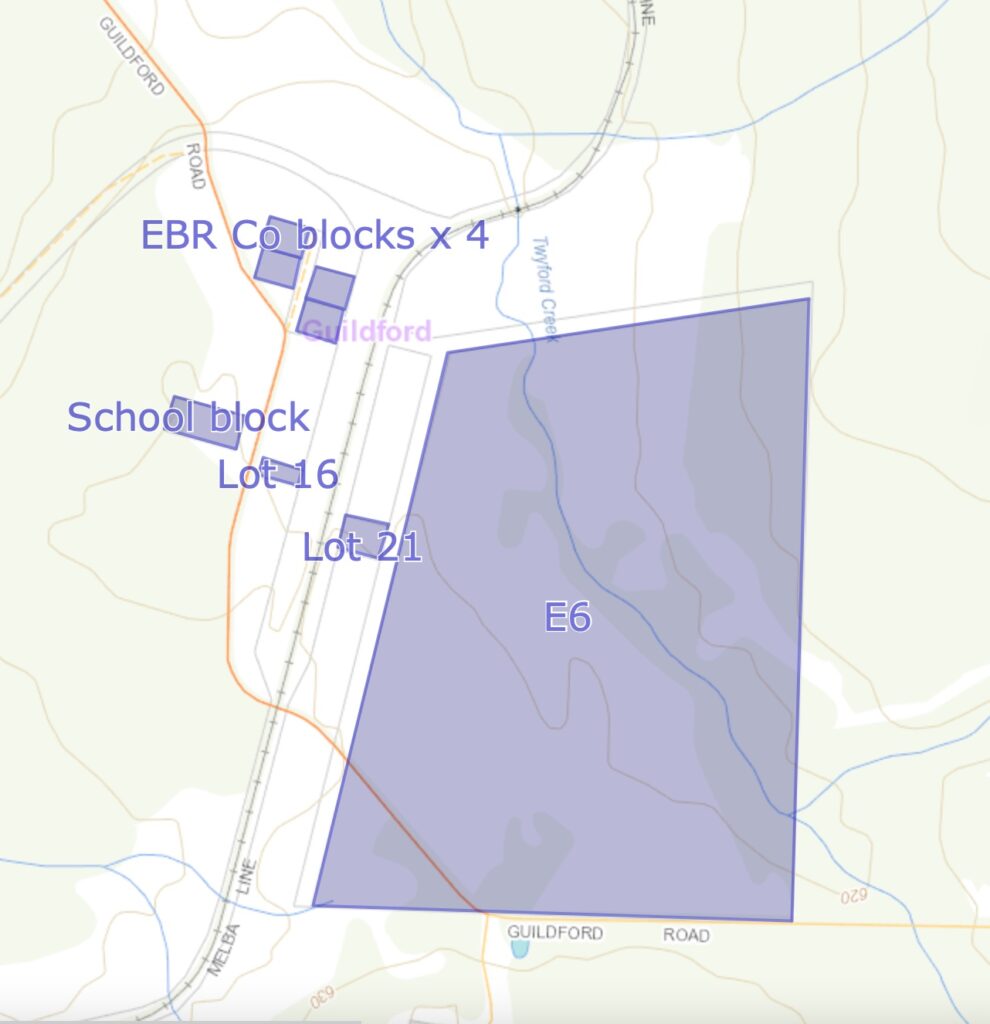
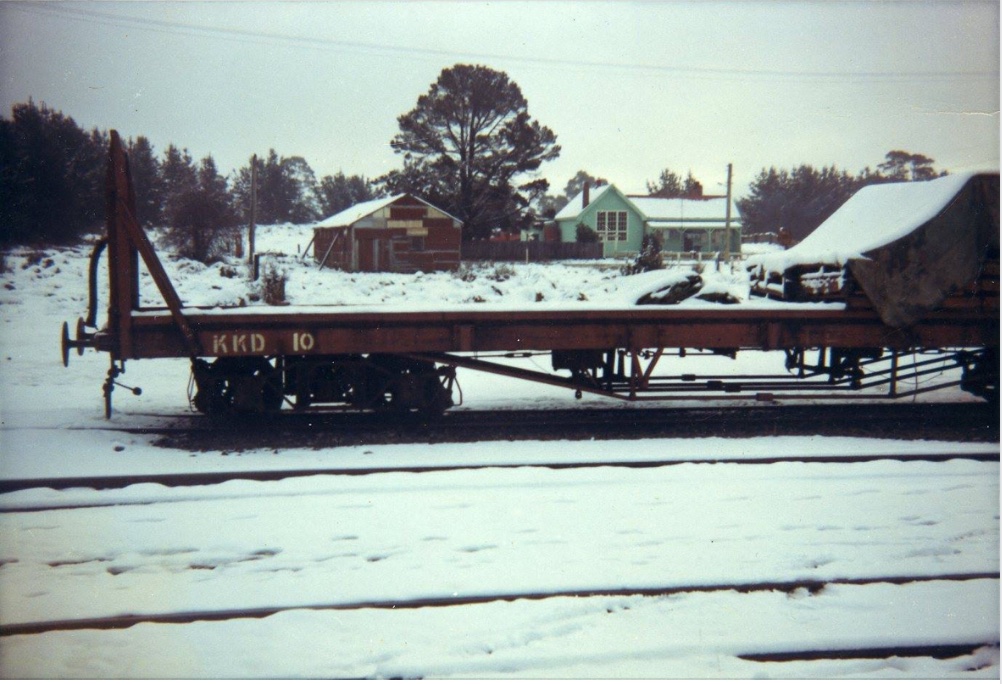
As part of the demise of Guildford as a town, the school closed in 1966. As mentioned earlier, this title was gifted to The Crown. Thus its legal basis was under General Law and the title again became Crown Land. In order for the Department of Education to deal with the property, it had to be converted to a title under the Real Property Act, 1862. When it was subsequently sold, it was granted as if for the first time ever. Tenders for the purchase of the buildings and land were advertised on 26 November 1966. The successful tenderer was Lawrence Snooks from Burnie, and he gained ownership of the title in April 1968. Wif Campbell subsequently bought the land off Snooks. The current owner, John Dart, purchased the block in 1983 for $200.
| VDL Co. Block Reference | Sold to | Area | Location | AFH/Papermakers purchase date | Current Title Reference |
| A1 | WH Atkinson | 115 acres | Chilton | 10/5/62 | 101919/2 |
| A7 | RG Hales | 249 acres | Wandle River | 15/11/68 | 102012/1 and 10213/2 |
| A8 | RG Hales | 172 acres | Belmont Plain | 15/11/68 | 102012/1 |
| B1 | WH Atkinson | 148 acres | Clipper East | 25/5/62 | 102010/1 |
| B7 | Dunkley Bros | 1,255 acres | Micklethwaite | 23/8/93 | 31443/1 |
| E6 | E Brown | 96 acres | Guildford | 12/2/48 | 101918/1 |
| K2 | E Owen | 204 acres | Ringwood | 27/4/62 | 101906/4 |
| K3 | CH & D Stitz | 179 acres | Ringwood | 27/4/62 | 101906/6 |
| K3a | CH & D Stitz | 64 acres | Ringwood | 27/4/62 | 101906/5 |
| M2 | WH Atkinson | 152 acres | Thompsons Park | 27/9/55 | 102011/1 |
| M3 | WH Atkinson | 310 acres | Burghley | 27/9/55 | 102011/2 |
[1] Sams’ map was also a detailed vegetation map showing the boundaries of different vegetation communities. The main reason for the vegetation mapping was so the VDL Co. could retain the ‘forest land’ for timber utilisation in the future. This plan has proved useful in understanding vegetation dynamics across the landscape by comparing remnant native areas to the past. See Bowman et al (2017) Soil or fire? What causes treeless sedgelands in Tasmanian wet forests? Plant Soil 420:1-18
[2] Now known as Clipper East.
[3] The Chilton block was surveyed at 115 acres.
[4] George Dunkley was born in 1867 in Hobart. He started business first at Trial Harbour about 1889, forwarding supplies and contracting. After two years of that work, he moved to Zeehan where he operated a sawmill and accepted contracts for timber with the mines and the Zeehan Town Board. His company, Dunkley Bros Ltd, bought the Zeehan Tramway Company in 1919 to transport timber to its Zeehan sawmill. With the result he built a large and lucrative business. He was Managing Director of Dunkley Bros Ltd. He operated sawmills at Zeehan, Waratah, Rosebery, Myalla, Trowutta, Sunny Hills and Stanley (started 1918). His brothers were William (Waratah), Thomas, Andrew and Robert (Hobart), Edgar and Edward (New Zealand). George died in June 1924.
[5] The cattle only grew in the head and horns.
[6] This refers to the protracted negotiations over Surrey Hills that eventually led to the sale of Surrey Hills to Papermakers Pty Ltd in 1930. The area of Surrey Hills at that time did not include Ringwood, approximately 25,000 acres. So, 125,540 less 207 acres for the railway and 2,121 acres sold or under contract were part of the discussions.
[7] Known as the ‘Squire of Guildford’ Edward Brown was the holder of the liquor license and ran the refreshment room and guest house.
[8] Hales was born in Penguin in 1864. He claimed to be the first infant born in the Penguin district. He was the mine manager at Magnet for 20 years from 1912. He gained his apprenticeship under John Craze, the manager of the Zeehan Montana silver mine and considered one of the best silver mine managers in Australia. Burnie farmer and historian, Richard Hilder, was his brother-in-law.
[9] Thomas William Field was the third son of William Field senior, the patriarch of the Field dynasty. Thomas was the real bushman of the brothers, going on the annual musters at Middlesex. He died relatively early in 1881. His son Richard Charles Field was born in 1866. He was very active in the high country until at least the 1940s where he had large holdings at Gads Hill and Borradaile Plains. Ethelyn Lindsay Field is the eldest daughter of Thomas William and Richard Charles’ sister. Richard Randle Field is Richard Charles’ son.
[10] AFH didn’t exist until it was incorporated on 2 March 1956. Papermakers Pty Ltd was the original company which managed the forests and sawmilling business owned by APPM. In 1953, the APPM Board changed the name to Burnie Board and Timber Pty Ltd as it was not considered an appropriate name for an organisation engaged in the manufacture of ‘Burnie Board’ and sawmilling.
[11] Forest Supplies Pty Ltd was a company formed in November 1936 to organise the cutting and delivery of pulpwood and firewood to the APPM pulp and paper mill in Burnie. It was established by VDL Co. Chief Agent A.K. McGaw who appointed VDL Co. surveyor, Jack Fidler, as its manager.
[12] Captain William Jones was a successful businessman in Burnie during its formative years in the late nineteenth century. He began the production of bricks on his farm at Cooee Creek in 1878 and was a pioneer sawmiller, hotelier and shipping company owner who also served as the first Harbour Master and was the long-time Warden of the Marine Board. He earned the title ‘King of Burnie’ in recognition of his hard work towards Burnie’s development. Most notably he built Jones’ Hotel (later the Bay View) in 1875 and the mansion ‘Menai’ in 1878. The building located at 10 Marine Terrace Burnie was constructed in 1887 by Jones for his Auction Mart on the ground floor. The middle floor was a skating rink and the top floor hotel rooms. When a new wharf was completed at the Burnie Port in 1901, it was named in his honour.
[13] Chapter 9 of ‘Fires, Farms and Forests’ on pages 142-6 outlines how AFH tried to improve the carrying capacity of the grasslands and developed a world-class Red Angus breeding herd which grazed on Surrey Hills during mid-summer from 1957 until the early 1960s.
[14] The Emu Bay Railway was included in the October 1984 sale of EZ Industries to North Broken Hill Peko which in 1988 merged with CRA Limited to form Pasminco. AN Tasrail was formed in 1978 after the Tasmanian Government transferred all its railway services, deep in debt, to the Commonwealth. Originally a subsidiary of the Federal Government’s Australian National, it was privatised and sold to Australian Transport Network (ATN) in 1997. On 22 May 1998, ATN purchased the only other rail operator, the Emu Bay Railway from Pasminco. It operated the Tasmanian rail network until 2004 when it was acquired by Pacific National. In 2009, the Tasmanian Government purchased the AN Tasrail business from Pacific National, via TasRail, a government state-owned enterprise.
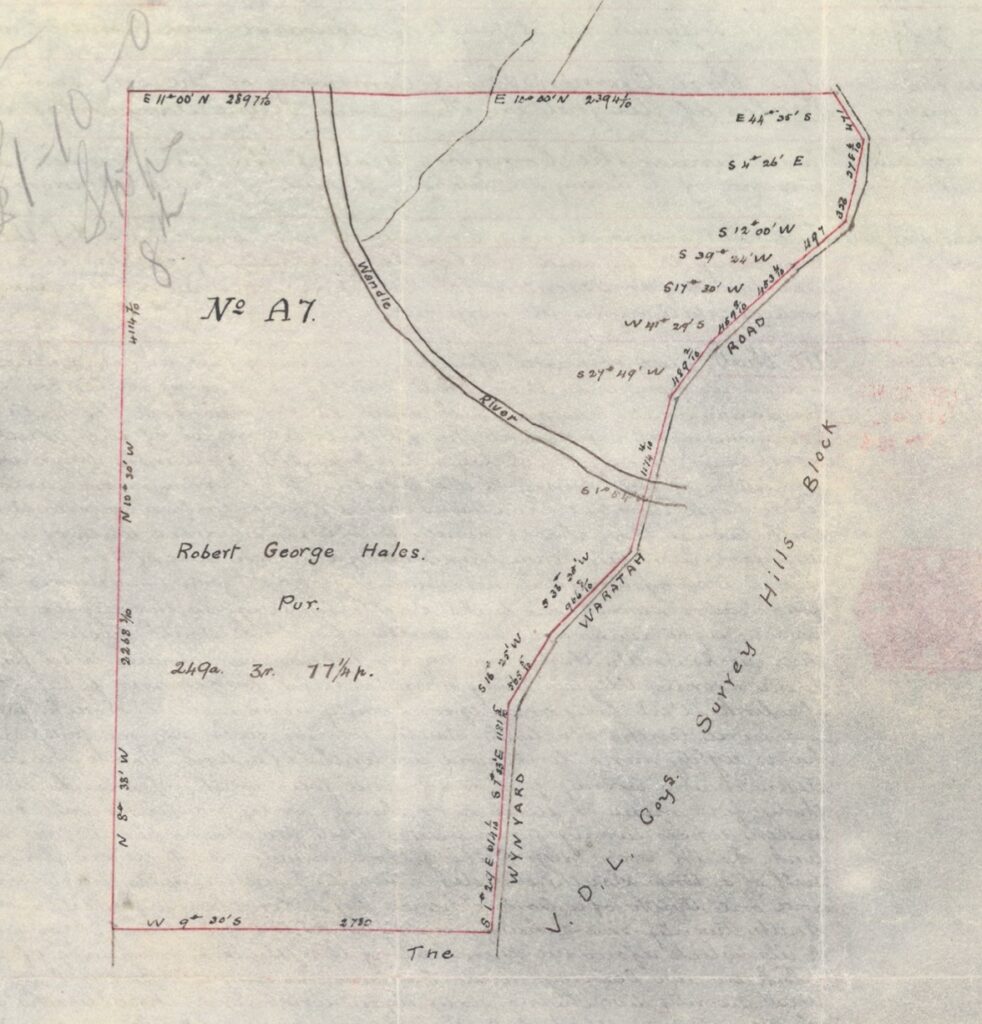
And another great story Robert. I recognised more than a few Surrey Hills road names in that smorgasbord of people involved in past leasing or ownership of SH blocks.
Robert, very detailed work indeed – I admire your patience.
I had no idea that whilst I was working for AFH from 1978 to 1986, Kauri Timber owned the Micklethwaite Marsh block (B7) – not that I recall any forestry activity in that area during those years.
Leigh Titmus
Thanks Rob.
Most interesting!
Regards
Ron Gregory
Very informative Rob.
I worked in this area for about 38 years, so much I had no idea about. Most of the names mentioned I recognise, but had no idea of the connections.
Great work.
Excellent reading Rob, very informative.
Hi Rob, very interesting. Leon
Enjoyed the read. Had no idea of the complexity of land and titles.
Brian Rollins is a walking library on the history and I am glad you know him.
Cattle grazing in the above area was never easy, the buttongrass made meat tough and brought low prices.
During the 60’s cattle were moved to other areas to soften their flesh.
Great work Robert, made an interesting read thank you.
Great read Rob,
Brought back many memories and especially the purchase of the Kauri Timber block which Bruce Hodgetts & I were involved in. Lots of the names and old title references rekindled memories of my time on Surrey Hills.
Well done Robert, excellent Job – Interesting read.
Many thanks for a very informative blog about our Atkinson family. We are 4th generation from WH Atkinson, still farming on his original cattle run off land at Upper Natone.
Donald Campbell Atkinson was a brother to W F (Fred) Atkinson our ancestor, who also enjoyed escapades in the Surrey Hills. Recently we visited Thompson’s Hut & marveled at its maintenance & relived the beautiful location of days gone by.
Your book “Fires, Farms & Forestry ” is a valuable purchase that we will treasure.
Thank you for all your interesting research.
Ian & Christine Atkinson Upper Natone
Hi Ian
Glad you enjoyed the information about your family and I hope you enjoy the book.
Regards
Robert
This is an excellent read Robert. I see my uncles, George and Edgar Luke, leased small lots at Guildford.
George worked on the railway until he retired. Edgar moved to Queenstown to work at Mt. Lyell.
David Luke
Thanks David. Glad you enjoyed the read.
It’s great to hear about the area’s history—an excellent read.
Cheers, Bevan Cooper, great-great-grandson of William Henry Atkinson.